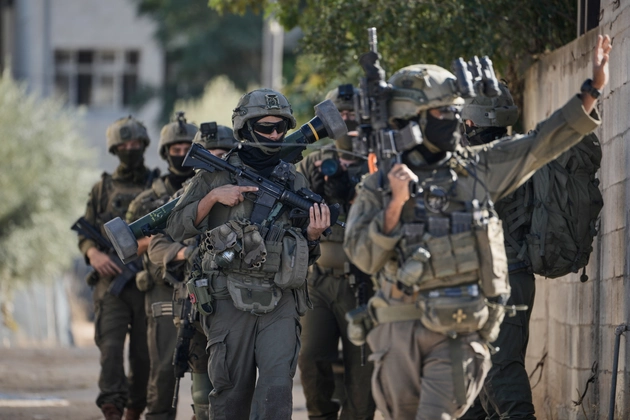Israel has its sights on Iran’s nuclear enrichment plant. But buried under a mountain in the ancient city of Qom, the closely-guarded Fordow facility is not an easy target. It’s the fortress of Iran’s nuclear programme, and according to reports, it has endured only partial damage after sustained strikes by Israel.
Iran could convert its current stockpile of 60 percent enriched uranium at the Fordow Fuel Enrichment Plant into 233 kilograms of weapons-grade Uranium (WGU) in just about three weeks, according to a US-based research and advocacy group, the Institute for Science and International Security.
“Around 233 kilograms of WGU would be enough to produce nine nuclear weapons, given that 25 kilograms of WGU is required to produce one nuclear weapon,” the institute’s latest assessment read.
Israel has also targeted a larger above-ground nuclear enrichment plant in Natanz, and another key raw material provider site in Isfahan.
These three key Iranian sites have been the focus of Israel’s attacks. Damage to these uranium enrichment sites will limit the country’s ability to produce nuclear weapons.
ThePrint explains what uranium enrichment is and how this process is critical in developing nuclear weapons.
What is uranium enrichment?
The Fordow facility, like any nuclear installation, is heavily guarded. Satellite images show five tunnels that go into the mountain, a support structure and heavily guarded perimeter. Whatever is known about it comes from intelligence gathered by Israel, but back in 2009, former US President Barack Obama had said that its “size and configuration is inconsistent with a peaceful programme”.
Only the U.S. military has a bomb that can reach it—a 30,000 pound ‘bunker buster’.
Iran is enriching uranium to up to 60 percent purity, according to the International Atomic Energy Agency (IAEA), the global nuclear watchdog. It could easily refine uranium further to roughly 90 percent, which is weapons-grade.
This, IAEA said, was a matter of concern because in the past, any country that has enriched uranium to such a level has only done so with the intention of producing nuclear weapons.
The process of uranium enrichment requires naturally occurring uranium and increasing the proportion of uranium-235, while removing uranium-238.
When uranium is dug out of the ground, the element is 99.27 percent uranium-238—consisting 92 protons and 146 neutrons—and only 0.72 percent uranium-235—92 protons and 143 neutrons.
To utilise this in nuclear power reactors and for weaponry, the proportions of this naturally occurring isotope need to be altered. This needs to be done because only uranium-235 can support a fission chain reaction.
During this process, a single free neutron strikes the nucleus of an atom of radioactive material, like uranium or plutonium, and sets two or three more neutrons free. When these neutrons split off from the nucleus, energy is released. The newly released neutrons go on to strike other uranium nuclei, splitting them again and releasing more energy and more neutrons. The chain reaction continues.
In a nuclear power plant, this reaction is carried out in a controlled manner, to produce electricity or for the purpose of nuclear medicine.
For nuclear weapons, this chain reaction needs to be carried out in a fraction of a second to cause an explosion.
Iran has four primary facilities under its nuclear programme—two at Nantaz, the Fuel Enrichment Plant and the Pilot Fuel Enrichment Plant, and the Fordow Fuel Enrichment Plant and the Uranium Conversion Facility in Isfahan.
Explained: What are centrifuges
In Natanz, the largest facility in Iran, around 20,000 centrifuges were operational. A centrifuge is a machine that enriches uranium. These machines perform the task of spinning the uranium in gas form. The rotors in the middle move at 60,000 to 70,000 rotations per minute, while the outer walls of the centrifuge spin at about 400 to 500 metres per second.
Because uranium-238 is heavier than uranium-235, it moves towards the walls of the centrifuge, while the lighter uranium-235 gets accumulated in the middle. The process is repeated several times over, to allow the percentage of uranium-235 collected to build up. The more the element is run through in the centrifuge, the more ‘enriched’ it becomes.
How much enrichment needed for nuclear weapons
A senior official of the Department of Atomic Energy in India explained that for civilian use, for power or medicine, “low-enrichment uranium” is enough.
“For civilian requirements, only about 2-3 percent uranium is enough. But for explosives, highly enriched uranium is required,” the official said.
Experts said that for advanced nuclear weapons, more enriched uranium is required. Countries that currently have nuclear weapons use 90 percent enriched weapons-grade uranium.
The primary difference between 60 percent and 90 percent enriched uranium is the purity of uranium-235. So, it is easier for nuclear agencies to get from 60 percent enriched uranium to 90 percent, because the amount of uranium-238 that needs to be eliminated keeps reducing the more it stays and spins in the centrifuge machine.
“Nuclear energy itself can be utilised for various purposes, and weapons are just one of the uses. It is a field where a lot of countries are investing,” the official from the department of atomic energy said.
Official Input From Theprint




















